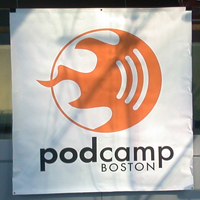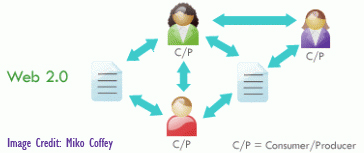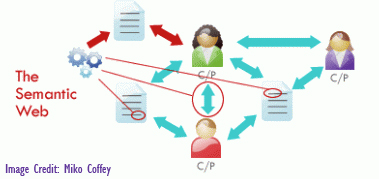Discuss Web 3.0: The Wave That Follows Social at PodCamp Boston
 This Saturday at 10AM Scott Brinker and I are hosting a discussion at Podcamp Boston on Web 3.0: The Wave that Follows Social.
This Saturday at 10AM Scott Brinker and I are hosting a discussion at Podcamp Boston on Web 3.0: The Wave that Follows Social.
Scott hosts the Chief Marketing Technologist Blog, and is founder and CTO of ION Interactive. His firm provides a suite of services that helps optimize search and Web experiences, which benefits both marketers and their audiences. He’s a legitimate tech and marketing visionary, and he runs a firm I’ve admired since they introduced me to the phrase “post-click segmentation.”
Saturday’s discussion is just the start of a dialog, and if you’re interested in this topic it would be great to hear from you or have you join us in person.
For those unfamiliar with Podcamp, it’s a sort of social media un-conference. You can get a better feel from this take on Podcamp4 in 2009, and Podcamp3 in 2008. It’s an enjoyable time to connect with the local social media community and to spot new ideas while they’re, well, new. Here’s the weekend’s schedule(pdf).
And to get a better feel for what this Web 3.0 stuff is about, take a look at the description below, and the links and video that follow.
First There Was Web 1.0: It Was Documents
 Originally, websites were collections of documents written in HTML, which when we were lucky referred to images. The phrase “Web page” made sense, because these documents contained copy and images like books.
Originally, websites were collections of documents written in HTML, which when we were lucky referred to images. The phrase “Web page” made sense, because these documents contained copy and images like books.
Then Came Web 2.0: Pages Generated by Applications
 Things like blogs, podcasts, video, and social networks seemed to arise separately. But together, they created a more social Web. Unlike the relatively static documents of Web 1.0, blogs, social networks and the like leveraged applications to generate “pages” from data held offline in databases. These applications (such as WordPress and Facebook) made it easy for people to publish or contribute content without coding pages themselves.
Things like blogs, podcasts, video, and social networks seemed to arise separately. But together, they created a more social Web. Unlike the relatively static documents of Web 1.0, blogs, social networks and the like leveraged applications to generate “pages” from data held offline in databases. These applications (such as WordPress and Facebook) made it easy for people to publish or contribute content without coding pages themselves.
Web 3.0 Puts the Application and the Data in Your Hands.
 Whether we’re using Salesforce, watching movies online, or using iPad applications, the concept of the Web page is falling away. This will dramatically change how users get interactive information and how marketers construct their presence on a siteless, pageless Web. The iPad, desktop applications, and mobile applications are pushing this idea forward.
Whether we’re using Salesforce, watching movies online, or using iPad applications, the concept of the Web page is falling away. This will dramatically change how users get interactive information and how marketers construct their presence on a siteless, pageless Web. The iPad, desktop applications, and mobile applications are pushing this idea forward.
What Will This Mean? Five Questions to Get Us Started:
- How will Web 3.0 change the tempo of marketing?
- How does it shift the skill set of marketing?
- What would that shift do to the organization of marketing?
- What about the value network of marketing, agencies, and outside providers?
- What remains the same about marketing?
During my years at Reuters, this more integrated experience was often framed in terms of data. And certainly Web 3.0’s data integration will be driven by XML and the conventions of the semantic web. However, Web 3.0 is happening today, and innovative companies aren’t waiting for a utopian vision of structured data to be achieved.
Here are some of my earlier posts on Web 3.0, and an excellent video of how some of the founders of the Web are thinking about it.
Related Posts
Web 3.0 – Envisioning the Web’s Next Big Change
The Siteless Web and the End of Brand Website Rule: Web 3.0
The 3 Buckets of Web Distribution: Get On To the Pageless Web
The Web is Dead” is Another Way to Talk About Web3.0
Web 3.0 from Kate Ray on Vimeo.

 The future of digital experiences will be built by strategists who grasp the full array of emerging business, social, and technical models. Specialties in user experience, branding, application design, and data science are laying the foundation for richer user experiences and business models breakthrough products and revenue based marketing.
The future of digital experiences will be built by strategists who grasp the full array of emerging business, social, and technical models. Specialties in user experience, branding, application design, and data science are laying the foundation for richer user experiences and business models breakthrough products and revenue based marketing.
4 Responses to "Discuss Web 3.0: The Wave That Follows Social at PodCamp Boston"
September 22, 2010
[…] forward 3 years, and today while helping a client with his WordPress blog, I noticed that he had a blog post about an upcoming Web 3.0 event – with none other than yours truly’s image being used to illustrate his point! He very […]
November 2, 2010
[…] for their annual digital marketing extravaganza in February, where I’ll be talking about Web3.0: The Wave That Follows Social Media. Slides from the session are posted […]
December 7, 2010
[…] was there on the course’s last day to talk about Web 3.0: The Wave That Follows Social. Makes sense, right? They’d focused on social marketing, and now I was helping frame it in the […]
June 16, 2011
[…] Kate Ray’s Web3.0 Video […]